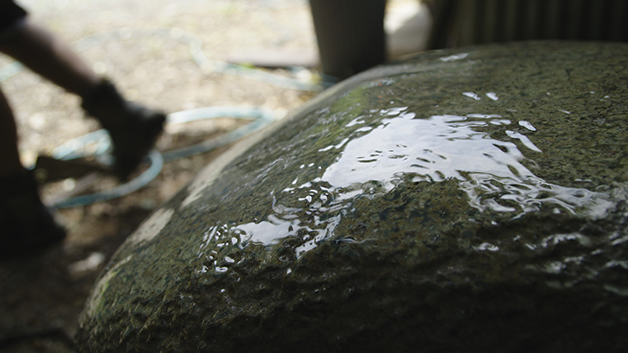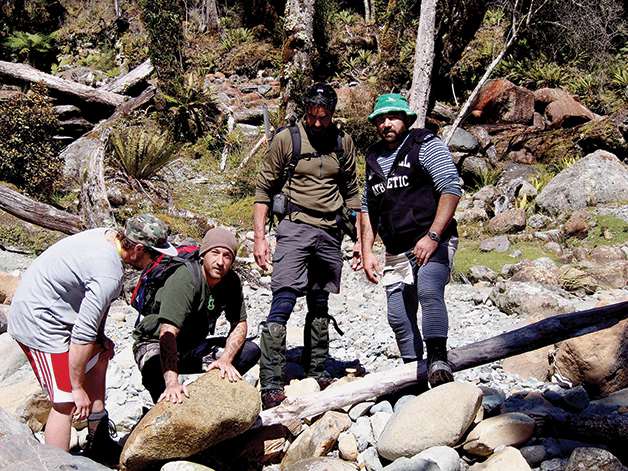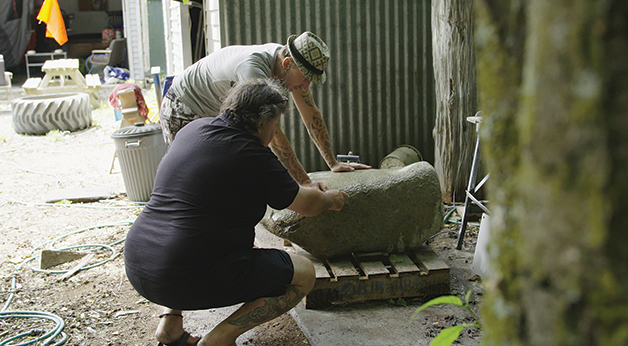The Right Stone
Jul 3, 2017

Following the devastating earthquakes of September 2010 and February 2011, Te Rūnanga o Ngāi Tahu worked with the Government and Christchurch City Council on the Canterbury Earthquake National Memorial. Called Oi Manawa (meaning ‘tremor of the heart’) the memorial pays respect to all those who were affected by the quakes. Of special significance is the pounamu kōhatu that sits at the entrance to the memorial, serving as a touchstone that connects visitors to the whenua and to those who have been before them. After working closely on the unveiling of the memorial in February of this year, kaituhi Adrienne Rewi shares the story of the kōhatu.

Close-up of kōhatu shows the rough crust that Fayne Robinson says represents the rubble of the earthquake, with the windows of green showing through to represent the potential within.
Mauri Tau Mauri Ora is the 270 kilogram pounamu kōhatu that sits on a Carrara marble plinth at the entrance to Oi Manawa, the Canterbury Earthquake National Memorial. Gifted by Te Rūnanga o Makaawhio, it marks a place for those affected by the Christchurch earthquakes to reflect and remember the people and places they have lost. It signposts a memorial to whenua, whānau, and memories.
For carver Fayne Robinson (Ngāi Tahu – Ngāti Māhaki, Ngāti Waewae; Ngāti Apa ki te Ra To – Puahaterangi), it is also a metaphor of sorts for the before and after of Christchurch city. Its rough crust, he says, resembles rubble; and the “little windows of potential”, showing in places, reflect where we are heading with the city rebuild.
“There was just something about this stone – its colour, its texture, its character that just said, ‘Pick me.’ Pounamu can be very diverse and many people have never seen it in its raw state, with its crusty exterior on show. They think of pounamu as being an obvious shade of green,” says Fayne.
“But it was that difference that drew me to this stone. It was a gut feeling, and I followed my instincts. The other two stones we sourced (from South Westland) were smaller and they fitted the more conventional idea of pounamu, but they lacked the character of this piece.”
“The stone carries mana and mauri of its own, the water brings its own cleansing wairua, and this is shared by everyone who touches it. There should be a sense of connection – whanaungatanga – a kinship or relationship gained through shared experiences, and the feelings the memorial invokes in all who visit it.”
Susan Wallace Makaawhio Rūnanga Representative
Fayne Robinson is no stranger to pounamu. He has a passion for the stone – and for his artwork – that stemmed from his childhood experiences. Born and raised on the West Coast, he was taken upriver looking for pounamu from an early age.
“We were never ‘dragged’ up the rivers as such, but that’s what it felt like to us. We were just kids. We just wanted to swim in the river, not hunt for stones.
“I’d do my sport on Saturday, and on Sunday, I’d be taken into the bush and upriver with my father and uncles. That was always the way – for as long as I can remember.”
Fayne says that from the first time he found pounamu he was hooked, but like most “stoners”, he believes there is much more to it than finding a stone.
“Those walks upriver through the bush are not so much about finding pounamu but developing a strong cultural connection to the environment and the elements. Finding a stone was always just a bonus – it still is; it’s really about connecting with the whenua.”
Fayne left the West Coast when he was 17. His parents wanted him to become a diesel mechanic in Christchurch, but he had no interest in cars. Instead, acting on the inspiration of Emily Schuster, head weaver at the New Zealand Māori Arts and Crafts Institute in Rotorua, he decided on a carving apprenticeship.
“Emily was taking a weaving wānanga on the Coast and she stayed with us. She noticed I was good at cooking and playing about with things, so she thought I’d be a good carver – or a chef. Two of my cousins had become chefs and I didn’t want to follow the pack, so I chose carving and headed for Rotorua.”
That was 1982, and after a three-year apprenticeship, Fayne stayed on at the institute for another four years to hone his skills. He says now though that it wasn’t until he had been carving for 20 years that “things just clicked,” and he felt free, inspired, and creative – “like a child given a pencil for the first time.”
Fayne specialised in whakairo (carving), mostly in wood. Although he had always had a strong connection to pounamu and a desire to carve it, it has only been over the last six years that he has done so.
“There were always other whānau members carving pounamu and there wasn’t a need for anyone else; and because of my classical training, my classical way of doing things, I have a slightly different approach.
“I have a very strong cultural connection to the stone and I put a huge value on it and it’s not about carving to fulfil any commercial imperative. I’m not carving pounamu to make a living. I don’t like compromising cultural integrity for the sake of a dollar. I have very set views about that. If it sells, it’s just a bonus, just as it’s always a bonus if you find the stone in the first place.”
It was Fayne’s deep knowledge and regard for pounamu and whakairo that led Matapopore Charitable Trust Kaitohutohu Toi (Arts Advisor) Tui Falwasser to approach him to source a stone for the National Earthquake Memorial on the edge of the Ōtākaro (Avon) River.
The Trust’s involvement in the memorial construction goes back to 2015. As the mana whenua voice in the city’s recovery, responsible for ensuring Ngāi Tūāhuriri/Ngāi Tahu values, aspirations and narratives are realised within the rebuilt city, Matapopore played a key role in making sure a cultural marker was stitched into the fabric of the memorial site.
“This was another opportunity for us to ensure a strong visual presence for the iwi within the new city,” says Tui (Ngāi Tahu – Ngāi Tūāhuriri).
“But the pounamu was always going to be much more than a simple visual presence. The Earthquake Memorial has a long life expectancy, and for us it was about strengthening that connection to the whenua; and for us as Ngāi Tahu/Ngāi Tūāhuriri, an opportunity to relate to the physical elements of the place.”
The memorial site, beside the Ōtākaro River, has a close relationship to the Ngāi Tahu-owned King Edward Barracks site, which has a much earlier history as a part of Puari Pā, and a key mahinga kai and nōhanga kāinga.
“The area is an historical anchor for us, and we wanted it to be a healing site for generations to come,” says Tui.
The first step in sourcing the right stone for the site was approaching the West Coast rūnanga, in this case Te Rūnanga o Makaawhio.
“Ngāti Waewae is already well represented in other areas of the city, so we chose Makaawhio – it’s about sharing the load and being inclusive of everyone, and this is the first time Makaawhio has been represented within the city for a number of years,” Fayne says.
Makaawhio Rūnanga Representative Susan Wallace says it was “a privilege and an honour to be able to tautoko such an important kaupapa, and to be able to share and express aroha with everyone who visits the memorial.”

Pounamu fossickers Jamie Robinson, Caleb Robinson, Garth Wilson and Scott Mills with the kōhatu Mauri Tau Mauri Ora at its South Westland entrance.
Susan says the rūnanga is fortunate in having a rōpū of motivated and committed Pounamu Committee members who were prepared to take up the challenge of finding an appropriate kōhatu mauri pounamu for the memorial.
“The kōmiti is chaired by Fayne Robinson, and he and his kōmiti members worked through the planning and logistical requirements that allowed Caleb Robinson, Jamie Robinson, Scott Mills, and Garth Wilson to fly to a remote South Westland valley, where the kōhatu was selected and extracted.
“We were thrilled to be able to contribute a kōhatu mauri that we believe not only appropriately reflects the weight of the kaupapa, but also provides an anchor in what is a wāhi aroha, wāhi maumaharatanga hoki,” Susan says.
Once the groundwork had been established, the trip into remote South Westland was planned for November 2016. Tui Falwasser says there was one small window of opportunity.
“We identified the best time safety-wise for the whānau and the helicopter pilot to go upriver; and of course it was always ‘weather permitting’. Fayne drove that side of things and we supported them with food, gear, health and safety plans, and accommodation; and
Te Rūnanga o Ngāi Tahu funded the helicopter extraction of the stone.”
For Fayne, it was appropriate that the four team members who went upriver all had strong connections to pounamu and a sound knowledge of the South Westland area.
“They’ve all been pounamu fossickers from an early age, and based on local whānau knowledge, we selected an area that we thought might be appropriate. The four guys took a 15-minute flight in from Haast, while I stayed behind to coordinate things at the base,” he says.
The team was divided in two and each pair was dropped off on a different tributary of the Gorge River, so they could walk towards each other, hunting for an appropriate stone as they went. When a stone was found, GPS coordinates were registered for helicopter pick-up, and Fayne was notified of the finds.
“The boys stayed in the bush overnight, and on the second day, a cameraman was helicoptered in to film the extraction for the documentary that was being made by Ōtākaro Limited, who worked with the Christchurch City Council and Te Rūnanga o Ngāi Tahu on the planning and construction of the memorial wall.
“That gave me the opportunity to also fly in and check out the three stones that the team had found. When I first saw them, I suggested we carry on looking for others. It’s always good to know that, if the opportunity arises and there’s a need for another stone for something else, we can go back to a known site and collect one.
“As for the right stone for the earthquake memorial – we decided to bring three stones out but from the outset, there was just something about the one we ultimately decided upon.”
The stones were secured into cargo nets and hoisted out in two helicopter trips. Two were left with Te Rūnanga o Makaawhio, and the final stone was brought to Fayne’s studio at Woodend, where he works with his nephew, Caleb Robinson.

Fayne Robinson and nephew Caleb Robinson inspecting the kōhatu shortly after extraction.
After the stone had been blessed, and in Fayne’s absence, the first challenge for Caleb was getting the 270kg stone off the back of the ute. In a moment of quick thinking, he and those helping rolled it off the truck and into an old La-Z-Boy chair.
From there, the decision was made to polish one side of it to create a smooth surface that would attract people to touch the stone. And to make the connection to the memorial wall itself, Fayne prepared a Carrara marble plinth, subtly sandblasted with appropriate Māori designs.
“Matapopore and Ngāi Tahu have played a big role in giving our iwi visible places in this city rebuild, and that’s good to see. I’m all for it,” says Fayne.
“We’ve had the opportunity to reveal a new face, and it’s been an honour to be involved in this memorial kaupapa.”
Tui Falwasser says the earthquake memorial reflects the strong collaborative nature of the committee that brought it to reality.
“It’s been the biggest anchor project Matapopore will be involved in, and it’s a manifestation of the excellent working relationships we formed in our work with Ōtākaro Limited, the Christchurch City Council, and Te Rūnanga o Ngāi Tahu,” Tui says.
“We see the placement of Mauri Tau Mauri Ora as a significant koha to the whānau, the iwi, the city, and the nation. I feel we’ve all done it justice, and it’s a great relief to know that those families affected by the injury or death of loved ones during the Christchurch earthquakes now have somewhere to go to reflect and heal their hurts.”
For Susan Wallace, the gifting of Mauri Tau Mauri Ora to the city maintains the tradition of placing mauri stones at the entrance to places of importance.
“The stone carries mana and mauri of its own, the water brings its own cleansing wairua, and this is shared by everyone who touches it. There should be a sense of connection – whanaungatanga – a kinship or relationship gained through shared experiences, and the feelings the memorial invokes in all who visit it.”